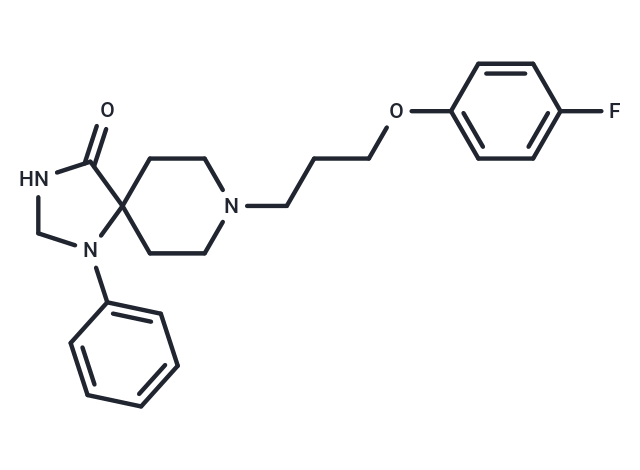Shopping Cart
Remove All Your shopping cart is currently empty
Your shopping cart is currently empty
AMI-193 (Spiramide) is an effective and selective antagonist of 5-HT2 and D2 receptor with Kis of 2, 3, 50, 2530, and 4300 nM for 5-HT2, D2 Receptor, 5-HT1A, D1 Receptor, and 5-HT1C Receptor. AMI-193 shows antipsychotic activity.

| Pack Size | Price | USA Warehouse | Global Warehouse | Quantity |
|---|---|---|---|---|
| 5 mg | $38 | In Stock | In Stock | |
| 10 mg | $58 | In Stock | In Stock | |
| 25 mg | $136 | In Stock | In Stock | |
| 50 mg | $223 | In Stock | In Stock | |
| 100 mg | $333 | - | In Stock | |
| 1 mL x 10 mM (in DMSO) | $42 | In Stock | In Stock |
| Description | AMI-193 (Spiramide) is an effective and selective antagonist of 5-HT2 and D2 receptor with Kis of 2, 3, 50, 2530, and 4300 nM for 5-HT2, D2 Receptor, 5-HT1A, D1 Receptor, and 5-HT1C Receptor. AMI-193 shows antipsychotic activity. |
| Targets&IC50 | D2 Receptor:3 nM (Ki), 5-HT1A receptor:50 nM (Ki), 5-HT2 receptor:2 nM (Ki), 5-HT1C receptor:4300 nM (Ki), D1 receptor:2530 nM (Ki) |
| In vivo | In adult male squirrel monkeys, AMI-193 (0.003 and 0.01 mg/kg; i.m.) decreases the response rate under a fixed-interval (FI) schedule of stimulus termination in a dose-dependent manner and under a second-order schedule of i.v. self-administration of cocaine (0.1 mg/infusion). AMI-193 (0.003 and 0.01 mg/kg; i.m.) attenuates the discriminative-stimulus effects of cocaine[2]. |
| Synonyms | Spiramide, Espiramida |
| Molecular Weight | 383.46 |
| Formula | C22H26FN3O2 |
| Cas No. | 510-74-7 |
| Smiles | FC1=CC=C(OCCCN2CCC3(CC2)N(CNC3=O)C2=CC=CC=C2)C=C1 |
| Relative Density. | 1.26 g/cm3 |
| Storage | Powder: -20°C for 3 years | In solvent: -80°C for 1 year | Shipping with blue ice/Shipping at ambient temperature. | |||||||||||||||||||||||||||||||||||
| Solubility Information | DMSO: 40 mg/mL (104.31 mM), Sonication is recommended. | |||||||||||||||||||||||||||||||||||
| In Vivo Formulation | 10% DMSO+40% PEG300+5% Tween 80+45% Saline: 2 mg/mL (5.22 mM), Sonication is recommended. Please add the solvents sequentially, clarifying the solution as much as possible before adding the next one. Dissolve by heating and/or sonication if necessary. Working solution is recommended to be prepared and used immediately. The formulation provided above is for reference purposes only. In vivo formulations may vary and should be modified based on specific experimental conditions. | |||||||||||||||||||||||||||||||||||
Solution Preparation Table | ||||||||||||||||||||||||||||||||||||
DMSO
| ||||||||||||||||||||||||||||||||||||
| Size | Quantity | Unit Price | Amount | Operation |
|---|

Copyright © 2015-2026 TargetMol Chemicals Inc. All Rights Reserved.